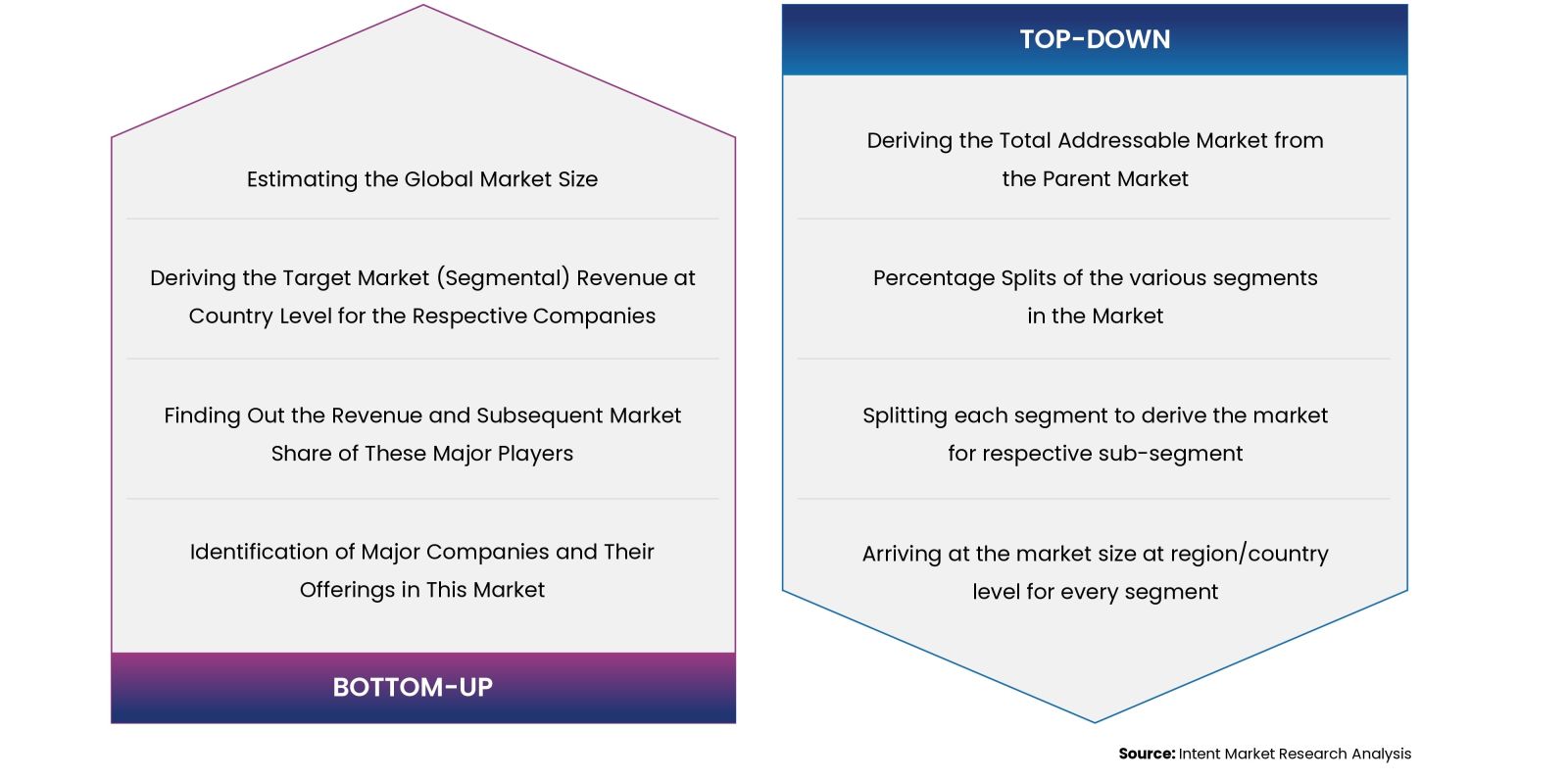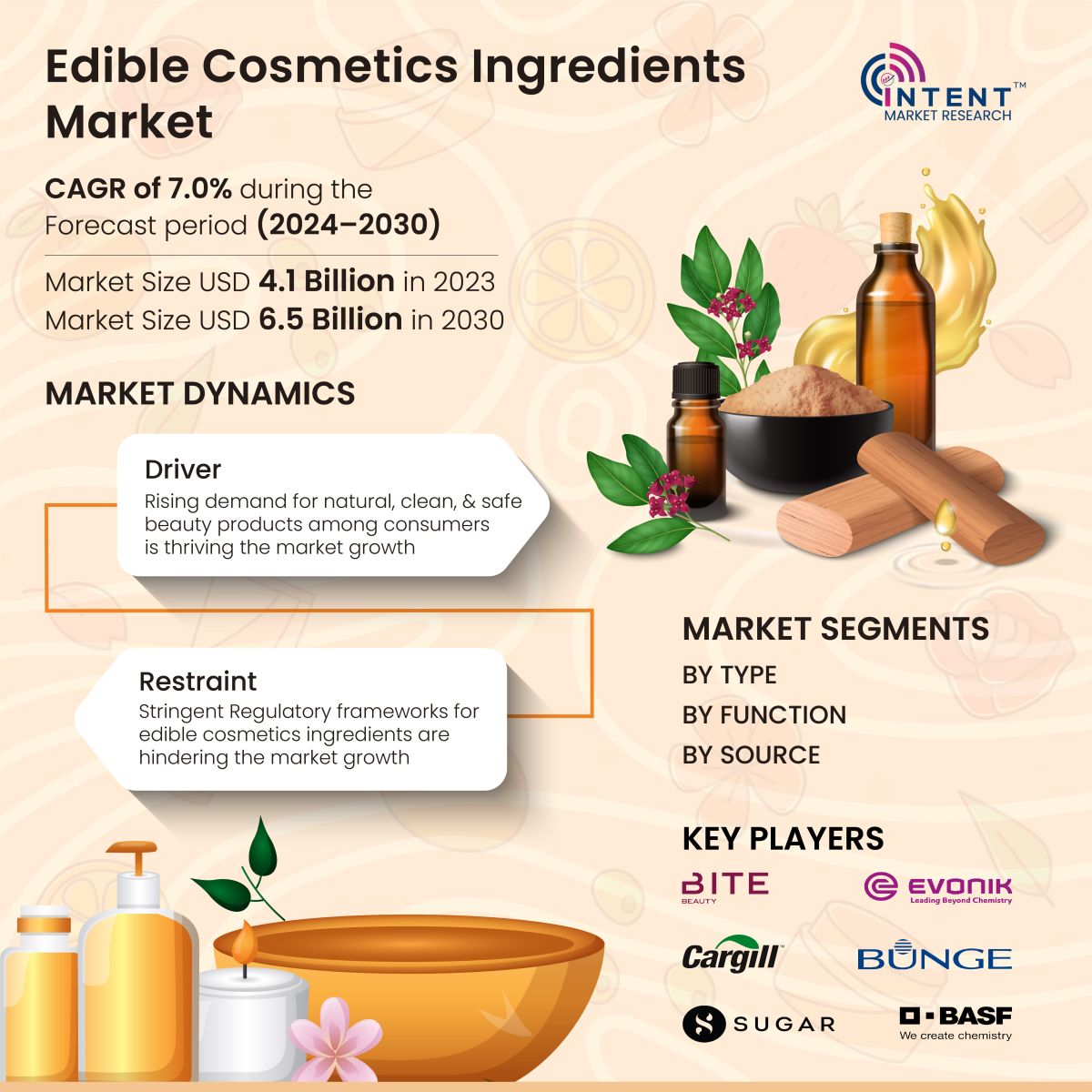According to Intent Market Research, the Edible Cosmetics Ingredients Market is expected to grow from USD 4.1 billion in 2023-e at a CAGR of 7.0% to touch USD 6.5 billion by 2030. Key players in this market include Ajinomoto, Aryan International, Auro Gums, BASF, Berg + Schmidt, Bite Beauty, Bunge, Cargill, Clariant, Darling Ingredients, DSM Nutritional, Evonik, Hallstar, IOI, Oleochemicals, Koster Keunen, Lonza, LUSH Cosmetics, Neo Australia, Sugar Nail, and Tarte Cosmetics. Advances in food technology have enabled the extraction and processing of cosmetic-grade ingredients from food sources driving the market.
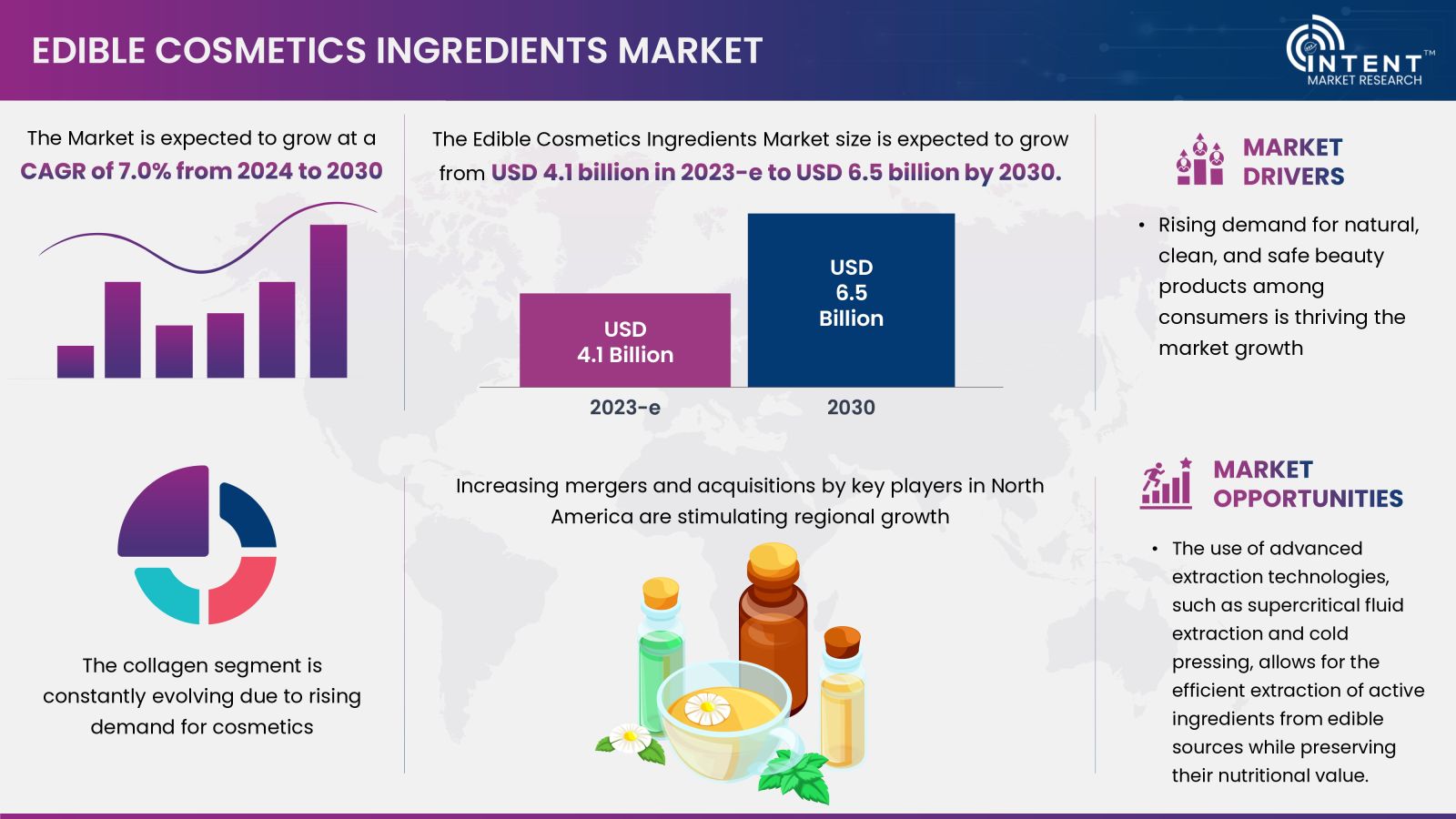
Click here to: Get FREE Sample Pages of this Report
Edible cosmetic ingredients are utilized in the production of beauty products, including formulations for skincare, hair care, nail-care nail care, and other body-related applications. These active ingredients are selected for their specific beneficial properties and are derived from natural, non-toxic, and food-grade sources such as plants, herbs, fruits, or essential oils. The term "edible" means that these ingredients are safe enough to be applied to the skin or in case ingested orally.
Edible Cosmetics Ingredients Market Dynamics
Rising Demand for Natural, Clean, and Safe Beauty Products Among Consumers is Thriving the Market Growth
Wellness-focused consumers are looking to improve their overall health and appearance, and brands offer personalized solutions for various skin concerns. Brands are progressively emphasizing ingredients sourced from plant extracts that are natural, organic, and vegan, aiming to attract consumers who prefer to avoid synthetic and chemical components.
Consumers are increasingly researching beauty products online to find the most effective products that contain scientifically proven ingredients such as spermidine, NMN, L-cysteine, and astaxanthin that improve both beauty and health. These products not only provide skincare benefits but also promote overall well-being, adapt to different lifestyles, are convenient, and bring a sense of joy to everyday life.
Edible Cosmetics Ingredients Market Segmental Insights
The Collagen Segment Is Constantly Evolving Due to Rising Demand for Cosmetics
Collagen accounted for the largest share of the edible cosmetic ingredients market in 2023. In November 2022, Zurvita company developed a new antioxidant collagen gel in collaboration with doctors, scientists, and researchers. Zondora is said to transform the skin and give it a healthy glow when taken orally. Gelatin helps to improve consistency, elasticity, and stability. Gelatin can also be used to normalize gut hormones in obese people. It is used to protect the skin, brighten, and prevent skin aging. It is a good product for consumers because it is used to improve skin health and control weight.
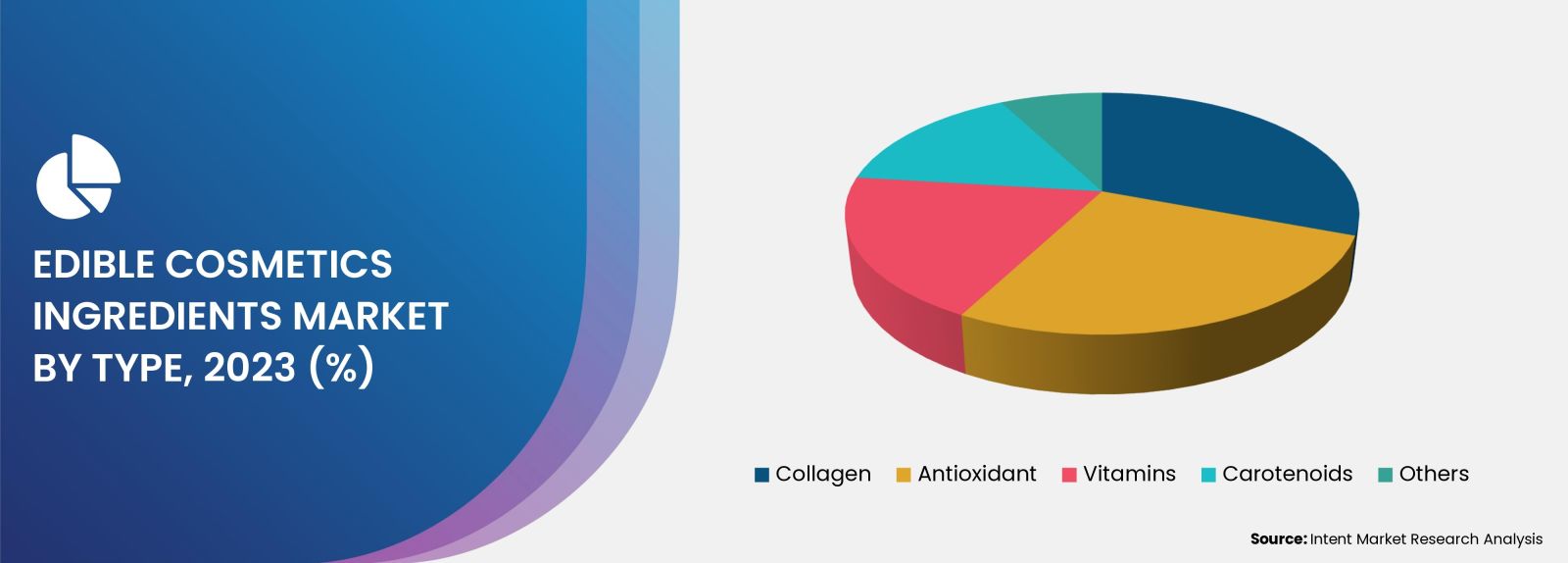
The Skincare Function is Responsible for the Higher Revenue Generation in the Edible Cosmetics Ingredients Market
The skin care function accounted for the largest share of the edible cosmetic ingredients market in 2023. This is due to increased awareness regarding the use of edible cosmetic pills as well as the rise in skin diseases. The anti-inflammatory properties of edible cosmetic ingredients to treat various skin conditions are driving growth in the skin care functional segment. According to the Global Atopic Dermatitis Report 2022 published by the International Eczema Council, approximately 223 million people will be living with atopic dermatitis in 2023, including approximately 43 million people aged 1 to 4 years. The high prevalence and growing burden of these dermatological conditions are expected to drive the market growth. The increasing use of edible cosmetic ingredients in plastic surgeries is also driving growth in this segment thereby driving the overall industry growth.
Plant-Based Sources are Widely Used in Edible Cosmetics Ingredients propelling the Market Growth
Plant-based ingredients are often seen as a natural and safe option for use on the skin. They appeal to consumers who prefer products with minimal synthetic additives or harsh chemicals. These ingredients are generally gentler and less likely to cause adverse reactions or irritations. Plants contain various vitamins, minerals, antioxidants, and phytonutrients that are beneficial for skin health. These compounds can provide hydration, nourishment, protection against environmental stressors, and support various skin functions. Plant-based ingredients offer versatility in skincare formulations.
Regional Insights
Increasing Mergers and Acquisitions by Key Players in North America are Stimulating Regional Growth
North America dominated the edible cosmetic ingredients market with a major share in 2023, owing to the increasing research and development and proliferation of improved medicines. Increasing consumption of dietary supplements, increasing health benefits of edible cosmetic ingredients, rising healthcare expenditure, and improving healthcare infrastructure are driving the growth of the market in this region. For example, in June 2023, Solabia acquired Applechem, an American provider of cosmetics technology. This strengthens the company's presence in the US market and allows it to benefit from a broader range of ingredients. This collaboration will enable the two companies to leverage their collective expertise, providing an expanded portfolio of high-performance components to a broader customer base.
Competitive Landscape
The Merger and acquisition Strategies Along with the Product Innovations by Major Players Are Driving the Market Growth
The edible cosmetics ingredients market is highly competitive, with numerous international and domestic players vying for market share. Key players in this market include Ajinomoto, Aryan International, Auro Gums, BASF, Berg + Schmidt, Bite Beauty, Bunge, Cargill, Clariant, Darling Ingredients, DSM Nutritional, Evonik, Hallstar, IOI, Oleochemicals, Koster Keunen, Lonza, LUSH Cosmetics, Neo Australia, Sugar Nail & Tarte Cosmetics. For instance, In February 2022, Merck introduced two new cosmetic ingredients, RonaCare Baobab, and RonaCare Hibiscus. These ingredients are derived from nutrient-rich superfoods, specifically the baobab fruit and the hibiscus flower. Their beneficial effects can also be utilized for skincare purposes.
Click here to: Get your custom research report today
Edible Cosmetics Ingredients Market Coverage
The report provides key insights into the edible cosmetics ingredients market, and it focuses on technological developments, trends, and initiatives taken by the government in this sector analysis explores market drivers, restraints, opportunities, and other relevant factors. It also examines key players and the competitive landscape within the market for edible cosmetics ingredients.

Report Scope
|
Report Features |
Description |
|
Market Size (2023-e) |
USD 4.1 billion |
|
Forecast Revenue (2030) |
USD 6.5 billion |
|
CAGR (2024-2030) |
7.0% |
|
Base Year for Estimation |
2023-e |
|
Historic Year |
2022 |
|
Forecast Period |
2024-2030 |
|
Report Coverage |
Revenue Forecast, Market Dynamics, Competitive Landscape, Recent Developments |
|
Segments Covered |
By Type (Antioxidants, Collagen, Vitamins, Carotenoids, and others), by Function (Skin Care, Weight Management, Hair Care, Nail Care, and Others), By Source (Plant-based, Animal based & Others) |
|
Regional Analysis |
North America (US, Canada), Europe (Germany, France, UK, Spain, Italy), Asia-Pacific (China, Japan, South Korea, India), Latin America (Brazil, Argentina), Middle East & Africa (Saudi Arabia, South Africa, Turkey, United Arab Emirates) |
|
Competitive Landscape |
Ajinomoto, Aryan International, Auro Gums, BASF, Berg + Schmidt, Bite Beauty, Bunge, Cargill, Clariant, Darling Ingredients, DSM Nutritional, Evonik, Hallstar, IOI, Oleochemicals, Koster Keunen, Lonza, LUSH Cosmetics, Neo Australia, Sugar Nail, Tarte Cosmetics |
|
Customization Scope |
Customization for segments, region/country-level will be provided. Moreover, additional customization can be done based on the requirements. |
|
Purchase Options |
We have three licenses to opt for Single User License, Multi-User License (Up to 5 Users), Corporate Use License (Unlimited User and Printable PDF) |
|
1. Introduction |
||
|
1. 1. Study Assumptions and Edible Cosmetics Ingredients Market Definition |
||
|
1.2. Scope of the Study |
||
|
2. Research Methodology |
||
|
3. Executive Summary |
||
|
4. Edible Cosmetics Ingredients Market Dynamics |
||
|
4.1. Market Growth Drivers |
||
|
4.2 Market Growth Challenges |
||
|
5. Edible Cosmetics Ingredients Market Outlook |
||
|
5.1. Regulatory Landscape |
||
|
5.2 Technological advances and future opportunity analysis |
||
|
5.3. Business expansion & and product pipeline analysis |
||
|
5.4 Consumer Adoption Analysis |
||
|
5.5. Porter’s Five Forces Analysis |
||
|
5.6. Impact of COVID-19 on the Edible Cosmetics Ingredients Market |
||
|
5.7. Raw Material Analysis |
||
|
5.8. Value Chain Analysis |
||
|
5.9. Pestle Analysis |
||
|
6. Global Edible Cosmetics Ingredients Market Segmentation (Market Size & Forecast: USD billion, 2023 - 2030) |
||
|
6.1 Type |
||
|
6.1.1 Antioxidants |
||
|
6.1.2 Hyaluronic Acid |
||
|
6.1.3 Peptides |
||
|
6.1.4 Natural Extracts |
||
|
6.1.5 Others |
||
|
6.2 Function |
||
|
6.2.1 Skin Care |
||
|
6.2.2 Weight management |
||
|
6.2.3 Hair Care |
||
|
6.2.4 Nail Care |
||
|
6.2.5 Others |
||
|
6.3 Source |
||
|
6.3.1 Plant based |
||
|
6.3.2 Animal based |
||
|
6.3.3 Others |
||
|
6.4 Region |
||
|
6.4.1 North America |
||
|
6.4.2 Europe |
||
|
6.4.3 Asia-Pacific |
||
|
6.4.4 Latin America |
||
|
6.4.5 Middle East and Africa |
||
|
7. North America Edible Cosmetics Ingredients Market Segmentation (Market Size & Forecast: USD billion, 2023 - 2030) |
||
|
7.1 Type |
||
|
7.1.1 Antioxidants |
||
|
7.1.2 Hyaluronic Acid |
||
|
7.1.3 Peptides |
||
|
7.1.4 Natural Extracts |
||
|
7.1.5 Others |
||
|
7.2 Function |
||
|
7.2.1 Skin Care |
||
|
7.2.2 Weight management |
||
|
7.2.3 Hair Care |
||
|
7.2.4 Nail Care |
||
|
7.2.5 Others |
||
|
7.3 Source |
||
|
7.3.1 Plant based |
||
|
7.3.2 Animal based |
||
|
7.3.3 Others |
||
|
7.4 Country |
||
|
7.4.1 United States |
||
|
7.4.1.1 Type |
||
|
7.4.1.1.1 Antioxidants |
||
|
7.4.1.1.2 Hyaluronic Acid |
||
|
7.4.1.1.3 Peptides |
||
|
7.4.1.1.4 Natural Extracts |
||
|
7.4.1.1.5 Others |
||
|
7.4.1.2 Function |
||
|
7.4.1.2.1 Skin Care |
||
|
7.4.1.2.2 Weight management |
||
|
7.4.1.2.3 Hair Care |
||
|
7.4.1.2.4 Soothing & Calming |
||
|
7.4.1.2.5 Others |
||
|
7.4.1.3 Source |
||
|
7.4.1.3.1 Plant based |
||
|
7.4.1.3.2 Animal based |
||
|
7.4.1.3.3 Others |
||
|
7.4.2 Canada |
||
|
7.4.2.1 Type |
||
|
7.4.2.1.1 Antioxidants |
||
|
7.4.2.1.2 Hyaluronic Acid |
||
|
7.4.2.1.3 Peptides |
||
|
7.4.2.1.4 Natural Extracts |
||
|
7.4.2.1.5 Others |
||
|
7.4.2.2 Function |
||
|
7.4.2.2.1 Skin Care |
||
|
7.4.2.2.2 Weight management |
||
|
7.4.2.2.3 Hair Care |
||
|
7.4.2.2.4 Soothing & Calming |
||
|
7.4.2.2.5 Others |
||
|
7.4.2.3 Source |
||
|
7.4.2.3.1 Plant based |
||
|
7.4.2.3.2 Animal based |
||
|
7.4.2.3.3 Others |
||
|
8. Europe Market Edible Cosmetics Ingredients Segmentation (Market Size & Forecast: USD billion, 2023 - 2030) |
||
|
8.1 Type |
||
|
8.1.1 Antioxidants |
||
|
8.1.2 Hyaluronic Acid |
||
|
8.1.3 Peptides |
||
|
8.1.4 Natural Extracts |
||
|
8.1.5 Others |
||
|
8.2 Function |
||
|
8.2.1 Skin Care |
||
|
8.2.2 Weight management |
||
|
8.2.3 Hair Care |
||
|
8.2.4 Nail Care |
||
|
8.2.5 Others |
||
|
8.3 Source |
||
|
8.3.1 Plant based |
||
|
8.3.2 Animal based |
||
|
8.3.3 Others |
||
|
8.4 Country |
||
|
8.4.1 United Kingdom |
||
|
8.4.1.1 Type |
||
|
8.4.1.1.1 Antioxidants |
||
|
8.4.1.1.2 Hyaluronic Acid |
||
|
8.4.1.1.3 Peptides |
||
|
8.4.1.1.4 Natural Extracts |
||
|
8.4.1.1.5 Others |
||
|
8.4.1.2 Function |
||
|
8.4.1.2.1 Skin Care |
||
|
8.4.1.2.2 Weight management |
||
|
8.4.1.2.3 Hair Care |
||
|
8.4.1.2.4 Soothing & Calming |
||
|
8.4.1.2.5 Others |
||
|
8.4.1.3 Source |
||
|
8.4.1.3.1 Plant based |
||
|
8.4.1.3.2 Animal based |
||
|
8.4.1.3.3 Others |
||
|
8.4.2 France |
||
|
8.4.2.1 Type |
||
|
8.4.2.1.1 Antioxidants |
||
|
8.4.2.1.2 Hyaluronic Acid |
||
|
8.4.2.1.3 Peptides |
||
|
8.4.2.1.4 Natural Extracts |
||
|
8.4.2.1.5 Others |
||
|
8.4.2.2 Function |
||
|
8.4.2.2.1 Skin Care |
||
|
8.4.2.2.2 Weight management |
||
|
8.4.2.2.3 Hair Care |
||
|
8.4.2.2.4 Soothing & Calming |
||
|
8.4.2.2.5 Others |
||
|
8.4.2.3 Source |
||
|
8.4.2.3.1 Plant based |
||
|
8.4.2.3.2 Animal based |
||
|
8.4.2.3.3 Others |
||
|
8.4.3 Germany |
||
|
8.4.3.1 Type |
||
|
8.4.3.1.1 Antioxidants |
||
|
8.4.3.1.2 Hyaluronic Acid |
||
|
8.4.3.1.3 Peptides |
||
|
8.4.3.1.4 Natural Extracts |
||
|
8.4.3.1.5 Others |
||
|
8.4.3.2 Function |
||
|
8.4.3.2.1 Skin Care |
||
|
8.4.3.2.2 Weight management |
||
|
8.4.3.2.3 Hair Care |
||
|
8.4.3.2.4 Soothing & Calming |
||
|
8.4.3.2.5 Others |
||
|
8.4.3.3 Source |
||
|
8.4.3.3.1 Plant based |
||
|
8.4.3.3.2 Animal based |
||
|
8.4.3.3.3 Others |
||
|
8.4.4 Italy |
||
|
8.4.4.1 Type |
||
|
8.4.4.1.1 Antioxidants |
||
|
8.4.4.1.2 Hyaluronic Acid |
||
|
8.4.4.1.3 Peptides |
||
|
8.4.4.1.4 Natural Extracts |
||
|
8.4.4.1.5 Others |
||
|
8.4.4.2 Function |
||
|
8.4.4.2.1 Skin Care |
||
|
8.4.4.2.2 Weight management |
||
|
8.4.4.2.3 Hair Care |
||
|
8.4.4.2.4 Soothing & Calming |
||
|
8.4.4.2.5 Others |
||
|
8.4.4.3 Source |
||
|
8.4.4.3.1 Plant based |
||
|
8.4.4.3.2 Animal based |
||
|
8.4.4.3.3 Others |
||
|
9. Asia Pacific Edible Cosmetics Ingredients Market Segmentation (Market Size & Forecast: USD billion, 2023 - 2030) |
||
|
9.1 Type |
||
|
9.1.1 Antioxidants |
||
|
9.1.2 Hyaluronic Acid |
||
|
9.1.3 Peptides |
||
|
9.1.4 Natural Extracts |
||
|
9.1.5 Others |
||
|
9.2 Function |
||
|
9.2.1 Skin Care |
||
|
9.2.2 Weight management |
||
|
9.2.3 Hair Care |
||
|
9.2.4 Nail Care |
||
|
9.2.5 Others |
||
|
9.3 Source |
||
|
9.3.1 Plant based |
||
|
9.3.2 Animal based |
||
|
9.3.3 Others |
||
|
9.4 Country |
||
|
9.4.1 China |
||
|
9.4.1.1 Type |
||
|
9.4.1.1.1 Antioxidants |
||
|
9.4.1.1.2 Hyaluronic Acid |
||
|
9.4.1.1.3 Peptides |
||
|
9.4.1.1.4 Natural Extracts |
||
|
9.4.1.1.5 Others |
||
|
9.4.1.2 Function |
||
|
9.4.1.2.1 Skin Care |
||
|
9.4.1.2.2 Weight management |
||
|
9.4.1.2.3 Hair Care |
||
|
9.4.1.2.4 Soothing & Calming |
||
|
9.4.1.2.5 Others |
||
|
9.4.1.3 Source |
||
|
9.4.1.3.1 Plant based |
||
|
9.4.1.3.2 Animal based |
||
|
9.4.1.3.3 Others |
||
|
9.4.2 Japan |
||
|
9.4.2.1 Type |
||
|
9.4.2.1.1 Antioxidants |
||
|
9.4.2.1.2 Hyaluronic Acid |
||
|
9.4.2.1.3 Peptides |
||
|
9.4.2.1.4 Natural Extracts |
||
|
9.4.2.1.5 Others |
||
|
9.4.2.2 Function |
||
|
9.4.2.2.1 Skin Care |
||
|
9.4.2.2.2 Weight management |
||
|
9.4.2.2.3 Hair Care |
||
|
9.4.2.2.4 Soothing & Calming |
||
|
9.4.2.2.5 Others |
||
|
9.4.2.3 Source |
||
|
9.4.2.3.1 Plant based |
||
|
9.4.2.3.2 Animal based |
||
|
9.4.2.3.3 Others |
||
|
9.4.3 India |
||
|
9.4.3.1 Type |
||
|
9.4.3.1.1 Antioxidants |
||
|
9.4.3.1.2 Hyaluronic Acid |
||
|
9.4.3.1.3 Peptides |
||
|
9.4.3.1.4 Natural Extracts |
||
|
9.4.3.1.5 Others |
||
|
9.4.3.2 Function |
||
|
9.4.3.2.1 Skin Care |
||
|
9.4.3.2.2 Weight management |
||
|
9.4.3.2.3 Hair Care |
||
|
9.4.3.2.4 Soothing & Calming |
||
|
9.4.3.2.5 Others |
||
|
9.4.3.3 Source |
||
|
9.4.3.3.1 Plant based |
||
|
9.4.3.3.2 Animal based |
||
|
9.4.3.3.3 Others |
||
|
9.4.4 South Korea |
||
|
9.4.4.1 Type |
||
|
9.4.4.1.1 Antioxidants |
||
|
9.4.4.1.2 Hyaluronic Acid |
||
|
9.4.4.1.3 Peptides |
||
|
9.4.4.1.4 Natural Extracts |
||
|
9.4.4.1.5 Others |
||
|
9.4.4.2 Function |
||
|
9.4.4.2.1 Skin Care |
||
|
9.4.4.2.2 Weight management |
||
|
9.4.4.2.3 Hair Care |
||
|
9.4.4.2.4 Soothing & Calming |
||
|
9.4.4.2.5 Others |
||
|
9.4.4.3 Source |
||
|
9.4.4.3.1 Plant based |
||
|
9.4.4.3.2 Animal based |
||
|
9.4.4.3.3 Others |
||
|
10. Latin America Edible Cosmetics Ingredients Market Segmentation (Market Size & Forecast: USD billion, 2023 - 2030) |
||
|
10.1 Type |
||
|
10.1.1 Antioxidants |
||
|
10.1.2 Hyaluronic Acid |
||
|
10.1.3 Peptides |
||
|
10.1.4 Natural Extracts |
||
|
10.1.5 Others |
||
|
10.2 Function |
||
|
10.2.1 Skin Care |
||
|
10.2.2 Weight management |
||
|
10.2.3 Hair Care |
||
|
10.2.4 Nail Care |
||
|
10.2.5 Others |
||
|
10.3 Source |
||
|
10.3.1 Plant based |
||
|
10.3.2 Animal based |
||
|
10.3.3 Others |
||
|
10.4 Country |
||
|
10.4.1 Brazil |
||
|
10.4.1.1 Type |
||
|
10.4.1.1.1 Antioxidants |
||
|
10.4.1.1.2 Hyaluronic Acid |
||
|
10.4.1.1.3 Peptides |
||
|
10.4.1.1.4 Natural Extracts |
||
|
10.4.1.1.5 Others |
||
|
10.4.1.2 Function |
||
|
10.4.1.2.1 Skin Care |
||
|
10.4.1.2.2 Weight management |
||
|
10.4.1.2.3 Hair Care |
||
|
10.4.1.2.4 Soothing & Calming |
||
|
10.4.1.2.5 Others |
||
|
10.4.1.3 Source |
||
|
10.4.1.3.1 Plant based |
||
|
10.4.1.3.2 Animal based |
||
|
10.4.1.3.3 Others |
||
|
10.4.3 Argentina |
||
|
10.4.3.1 Type |
||
|
10.4.3.1.1 Antioxidants |
||
|
10.4.3.1.2 Hyaluronic Acid |
||
|
10.4.3.1.3 Peptides |
||
|
10.4.3.1.4 Natural Extracts |
||
|
10.4.3.1.5 Others |
||
|
10.4.3.2 Function |
||
|
10.4.3.2.1 Skin Care |
||
|
10.4.3.2.2 Weight management |
||
|
10.4.3.2.3 Hair Care |
||
|
10.4.3.2.4 Soothing & Calming |
||
|
10.4.3.2.5 Others |
||
|
10.4.3.3 Source |
||
|
10.4.3.3.1 Plant based |
||
|
10.4.3.3.2 Animal based |
||
|
10.4.3.3.3 Others |
||
|
11. Middle East & Africa Edible Cosmetics Ingredients Market Segmentation (Market Size & Forecast: USD billion, 2023 - 2030) |
||
|
11.1 Type |
||
|
11.1.1 Antioxidants |
||
|
11.1.2 Hyaluronic Acid |
||
|
11.1.3 Peptides |
||
|
11.1.4 Natural Extracts |
||
|
11.1.5 Others |
||
|
11.2 Function |
||
|
11.2.1 Skin Care |
||
|
11.2.2 Weight management |
||
|
11.2.3 Hair Care |
||
|
11.2.4 Nail Care |
||
|
11.2.5 Others |
||
|
11.3 Source |
||
|
11.3.1 Plant based |
||
|
11.3.2 Animal based |
||
|
11.3.3 Others |
||
|
11.4 Country |
||
|
11.4.1 United Arab Emirates |
||
|
11.4.1.1 Type |
||
|
11.4.1.1.1 Antioxidants |
||
|
11.4.1.1.2 Hyaluronic Acid |
||
|
11.4.1.1.3 Peptides |
||
|
11.4.1.1.4 Natural Extracts |
||
|
11.4.1.1.5 Others |
||
|
11.4.1.2 Function |
||
|
11.4.1.2.1 Skin Care |
||
|
11.4.1.2.2 Weight management |
||
|
11.4.1.2.3 Hair Care |
||
|
11.4.1.2.4 Soothing & Calming |
||
|
11.4.1.2.5 Others |
||
|
11.4.1.3 Source |
||
|
11.4.1.3.1 Plant based |
||
|
11.4.1.3.2 Animal based |
||
|
11.4.1.3.3 Others |
||
|
11.4.2 Saudi Arabia |
||
|
11.4.2.1 Type |
||
|
11.4.2.1.1 Antioxidants |
||
|
11.4.2.1.2 Hyaluronic Acid |
||
|
11.4.2.1.3 Peptides |
||
|
11.4.2.1.4 Natural Extracts |
||
|
11.4.2.1.5 Others |
||
|
11.4.2.2 Function |
||
|
11.4.2.2.1 Skin Care |
||
|
11.4.2.2.2 Weight management |
||
|
11.4.2.2.3 Hair Care |
||
|
11.4.2.2.4 Soothing & Calming |
||
|
11.4.2.2.5 Others |
||
|
11.4.2.3 Source |
||
|
11.4.2.3.1 Plant based |
||
|
11.4.2.3.2 Animal based |
||
|
11.4.2.3.3 Others |
||
|
11.4.3 South Africa |
||
|
11.4.3.1 Type |
||
|
11.4.3.1.1 Antioxidants |
||
|
11.4.3.1.2 Hyaluronic Acid |
||
|
11.4.3.1.3 Peptides |
||
|
11.4.3.1.4 Natural Extracts |
||
|
11.4.3.1.5 Others |
||
|
11.4.3.2 Function |
||
|
11.4.3.2.1 Skin Care |
||
|
11.4.3.2.2 Weight management |
||
|
11.4.3.2.3 Hair Care |
||
|
11.4.3.2.4 Soothing & Calming |
||
|
11.4.3.2.5 Others |
||
|
11.4.3.3 Source |
||
|
11.4.3.3.1 Plant based |
||
|
11.4.3.3.2 Animal based |
||
|
11.4.3.3.3 Others |
||
|
12. Competitive Landscape |
||
|
12.1 Company Market Share Analysis |
||
|
12.2 Competitive Matrix |
||
|
12.2 Product Benchmarking |
||
|
12.3 Company Profiles (Manufacturers of Edible Cosmetics Ingredients) |
||
|
12.3.1 Cargill |
||
|
12.3.1.1 Company Synopsis |
||
|
12.3.1.2 Company Financials |
||
|
12.3.1.3 Product/ Service Portfolio |
||
|
12.3.1.4 Recent Developments |
||
|
12.3.2 BASF |
||
|
12.3.3 Bunge |
||
|
12.3.4 Evonik |
||
|
12.3.5 Ajinomoto Co. |
||
|
12.3.6 DSM Nutritional |
||
|
12.3.7 Darling Ingredients |
||
|
12.3.8 Lonza |
||
|
12.3.9 Clariant |
||
|
12.3.10 IOI Oleochemicals |
||
|
12.3.11 Berg + Schmidt |
||
|
12.3.12 Hallstar |
||
|
12.3.13 Auro Gums |
||
|
12.3.14 Koster Keunen |
||
|
12.3.15 Tarte Cosmetics |
||
|
12.3.16 LUSH Cosmetics |
||
|
12.3.17 Neo Australia |
||
|
12.3.18 Aryan International |
||
|
12.3.19 Bite Beauty |
||
|
12.3.20 Sugar Nail |
||
|
12.4 Company Profiles (Demand Side) |
||
|
12.4.1 L'Oréal |
||
|
12.4.1.1 Company Synopsis |
||
|
12.3.1.2 Company Financials |
||
|
12.3.1.3 Product/ Service Portfolio |
||
|
12.3.1.4 Recent Developments |
||
|
12.4.2 Estée Lauder |
||
|
12.4.3 P&G |
||
|
12.4.4 Maybelline |
||
|
12.4.5 Kylie Cosmetics |
||
|
13. Analyst Recommendations |
||
Intent Market Research employs a rigorous methodology to minimize residual errors by carefully defining the scope, validating findings through primary research, and consistently updating our in-house database. This dynamic approach allows us to capture ongoing market fluctuations and adapt to evolving market uncertainties.
The research factors used in our methodology vary depending on the specific market being analyzed. To begin with, we incorporate both demand and supply side information into our model to identify and address market gaps. Additionally, we also employ approaches such as Macro-Indicator Analysis, Factor Analysis, Value Chain-Based Sizing, and forecasting to further increase the accuracy of the numbers and validate the findings.
Research Approach
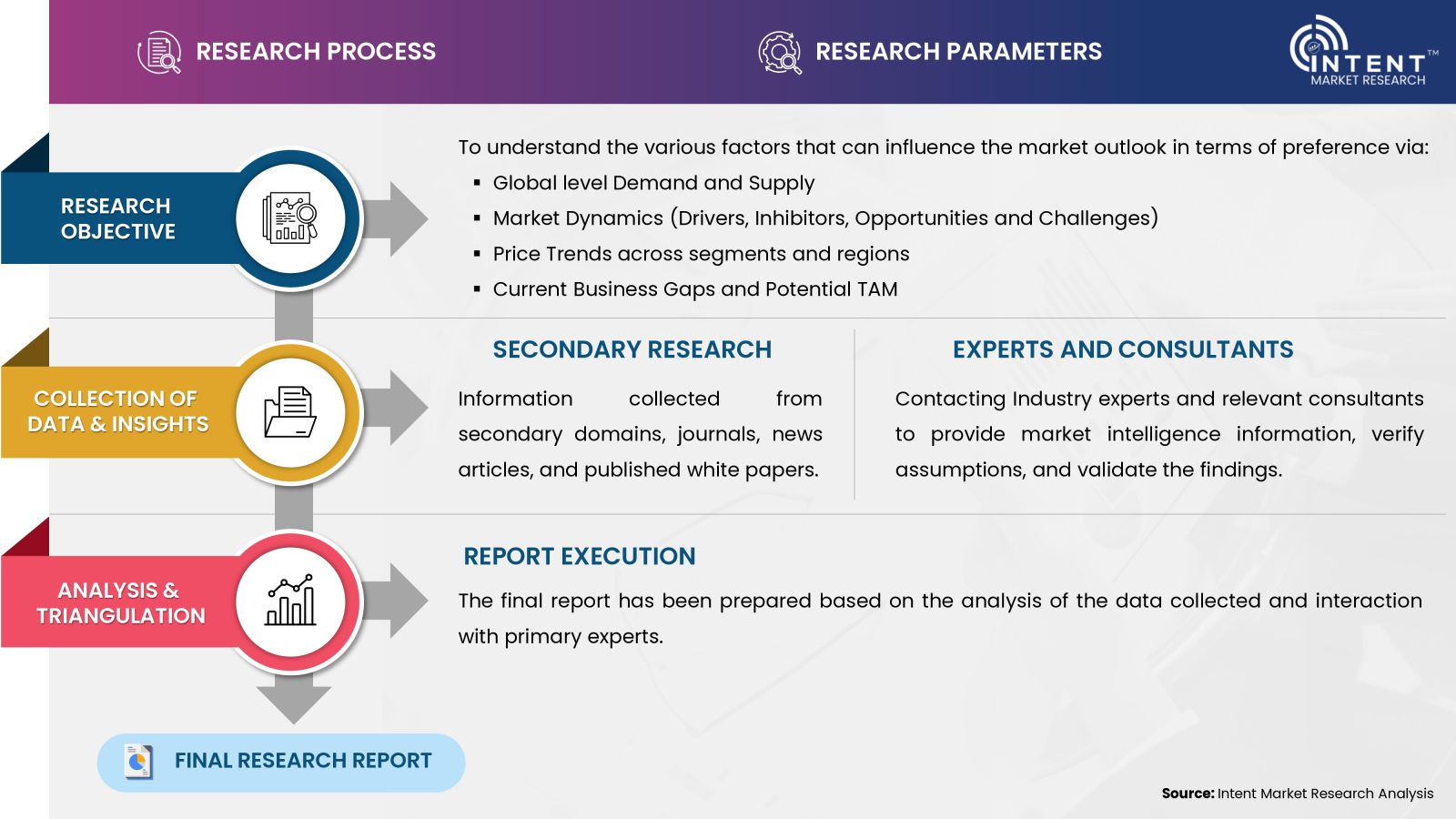
- Secondary Research Approach: During the initial phase of the research process, we acquire and accumulate extensive data continuously. This data is carefully filtered and validated through a variety of secondary sources.
- Primary Research Approach: Following the consolidation of data gathered through secondary research, we initiate a validation process to verify all the market numbers, and assumptions and validate the findings by engaging with subject matter experts.
Data Collection, Analysis and Interpretation:
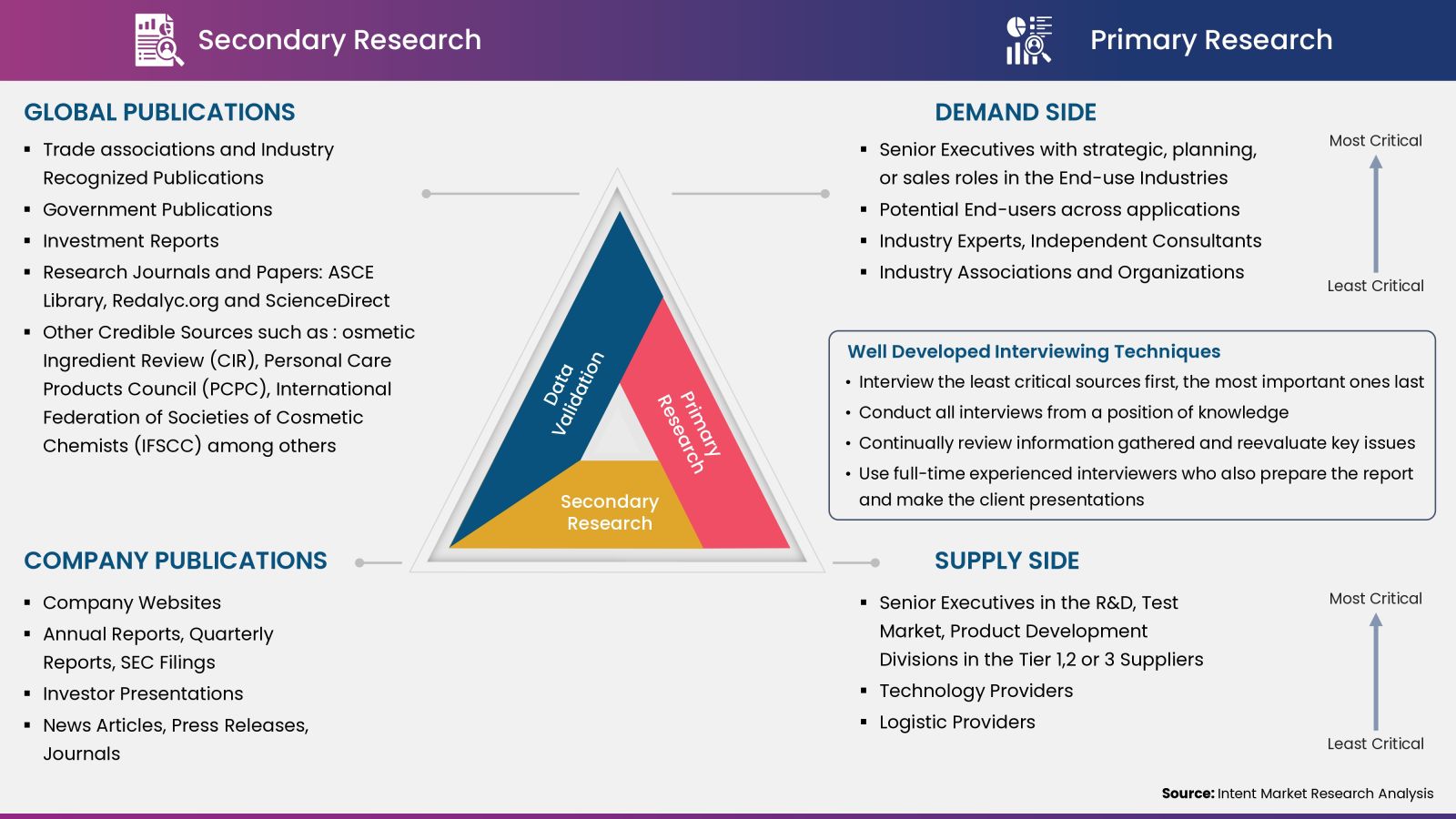
Research Methodology
Our market research methodology utilizes both top-down and bottom-up approaches to segment and estimate quantitative aspects of the market. We also employ multi-perspective analysis, examining the market from distinct viewpoints.
